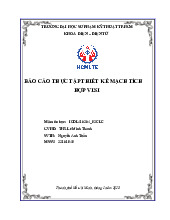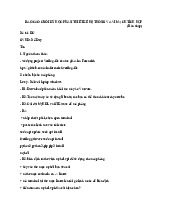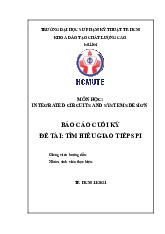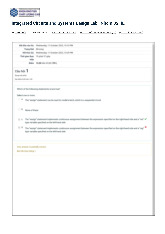



















Preview text:
lOMoAR cPSD| 58728417
Integrated Circuit and Digital system Design
Associate Professor. Truong Ngoc Son
Email: sontn@hcmute.edu.vn Mobile: 0931.085.929
Department of Computer and Communication Engineering
Faculty of Electrical and Electronics Engineering Tools lOMoAR cPSD| 58728417 ▪ Lecture notes ▪ Textbook ▪ Software ▪Xilinx ISE Design Suite
Truong Ngoc Son, Ph.D - Department of Computer and Communication Engineering lOMoAR cPSD| 58728417 Student activity Attending class
It is absolutely important that you attend class regularly (>80%) Solving the problem
Take all examinations ( including online exam, paper-based exams) Submit the homework on time
Truong Ngoc Son, Ph.D - Department of Computer and Communication Engineering lOMoAR cPSD| 58728417
Integrated circuit Design ASIC FPGA lOMoAR cPSD| 58728417
Integrated circuit Design lOMoAR cPSD| 58728417
Integrated circuit Design lOMoAR cPSD| 58728417 Introduction
❑ How to go from Idea/Algorithm to the actual hardware module RippleCarryAdderII (Cin, X, Y, S,Cout); parameter n = 4; input Cin; input [n- 1:0] X, Y; output [n-1:0] S; wire [n-1:0] C; Full_Adder stage0
(Cin, X[0], Y[0], S[0], C[1]); Full_Adder stage1
(C[1], X[1], Y[1], S[1], C[2]); Full_Adder stage2
(C[2], X[2], Y[2], S[2], C[3]); Full_Adder stage3 (.Cout(Cout), .Cin(C[3]), .x(X[3]), .y(Y[3]), .S(S[3])); endmodule lOMoAR cPSD| 58728417 Introduction ASIC FPGA
❑ Hardware Description Language (HDL) :Verilog
❑ Professional Verilog Coding for Synthesis
❑ Verification Techniques ❑ FPGA Architectures ❑ Digital System Design with Xilinx FPGAs lOMoAR cPSD| 58728417 Introduction
❑ ASIC Digital Design Flow (from Verilog to the actual
Chip!) ❑ Synthesis Algorithms ❑ Power Dissipation ❑ Power Grid
and Clock Design ❑ Fixed-point Simulation Methodology
❑ Detailed Design Optimization Workshop with ISE (for the fist time!) lOMoAR cPSD| 58728417 Introduction Standard Specifications Cells Pre-Layout Post-Layout Simulation Yes Timin g Yes Back Yes RTLCoding Synthesis APR Tim ing Logic Pass ? Alanysis An nota tion Alanysis v erification Pass? Pass? NO TestBench Timing NO NO Constrain ts Tapeout 1 . 2 .Simulation 3 .Synthesis 4 . Placement &routing 5 . Timing Analysis HDLCodin &Verification Front-End Back-End
❑ In this course we learn all the above steps in detailfor ➢ ASIC Platform ➢ FPGA Platform lOMoAR cPSD| 58728417 Introduction:
❑ Hardware Description Language
➢Verilog Fundamentals ▪ Language Fundamentals
▪ Modeling Combinational/Sequential Logic Circuits ▪ Modeling Finite State Machines
➢Verilog for Verification
▪ Verification/Simulation techniques with test-benches
➢Verilog for synthesis
▪ Verilog Styles for Synthesis
▪ Architectural techniques for high-speed designs o Parallel proc., pipelining, retiming, … lOMoAR cPSD| 58728417 Introduction: ▪ Implementations of common operations o Complex multiplication,
division, complex norm, CORDIC
▪ Fundamentals of fixed-point realization
❑ PLDs & FPGA Architectures ➢FPGA Technologies
▪ SPLDs (PAL and PLA architectures)
▪ Commercial CPLD Architectures ▪ SRAM/LUT Based FPGAs ▪ Anti-fuse/MUX Based FPGAs ▪ Flash Based FPGAs ➢FPGA Architectures
▪ Heterogeneous/Homogeneous FPGAs
▪ Fine-grained, coarse-grained and platform FPGAs lOMoAR cPSD| 58728417 Introduction: ➢FPGA Elements
& Design Trade-offs
▪ Logic Cells Common Architectures
▪ Programmable Routing Channels Design
▪ I/O & Pad architectures ➢Commercial FPGAs ▪ Altera (FLEX 10K, Stratix III) , Xilinx (XC4000, Virtex II,4,5), Actel (Act3, Axcelerator)
❑ Advanced Digital System Design with Xilinx FPGAs ➢ Design Creation ➢ Synthesize ➢ Simulation lOMoAR cPSD| 58728417 Introduction: ➢ Constraints Entry ➢ Implementation
➢ Implementation Results Analysis – Timing Analysis
➢ Implementation Results Analysis – Power Analysis
➢ Implementation Results Improvement
➢ Device Configuration and Programming ➢ Design Debugging ❑ Core Generator ➢ CORE Generator Tool
➢ Intellectual Property (IP) Cores lOMoAR cPSD| 58728417 Introduction: ➢ CORE Generator Tool files ➢ Design Flows ➢ Defining
Memory Contents for RAM and ROM ➢ Defining
Coefficient Values in a COE File ❑ ASIC Design Flow:
➢HDL Coding & Verification ➢Synthesis
& Timing Optimization
▪ Complete Synopsys Design Complier Design Flow ➢Physical Design ▪ Cadence First Encounter lOMoAR cPSD| 58728417 Introduction:
▪ Floorplan (Initial floorplan and power planning) ▪ Placement
(Full-scale floorplan and clock tree insertion)
▪ Routing (power routing & Nanoroute) ▪ Timing Closure (Analysis & Optimization of setup and hold
time violations) ▪ Fill (Filler Cells, Metal Fill, and Verify Geometry)
❑ CAD Tool Algorithms:
➢Synthesis Algorithms ➢Two-level Optimization
➢Multi-level Logic Optimization ➢Technology Mapping lOMoAR cPSD| 58728417 Introduction: ❑ Power Dissipation ➢ Power Dissipation concept ➢ Dynamic Power ➢ Static Power ➢ Challenges lOMoAR cPSD| 58728417 Introduction:
❑ Power Grid and Clock Design ➢ Power Distribution Design ▪ Introduction ▪ IR Drop ▪ Ldi/dt Drop ➢ Decoupling Capacitances ➢ Clock Considerations ➢ PLL/DLL Architecture ❑ Prerequisites: ➢Only Digital Logic! lOMoAR cPSD| 58728417 Introduction:
➢All the skills you need will be taught in the course ❑ Softwares you will learn: ➢Altera Quartus ➢Xilinx ISE ➢Mentor Graphics Modelsim ➢TCL Scripting ➢Synopsys Design Compiler ➢Cadence SOC Encounter
❑ Implementation Platform: lOMoAR cPSD| 58728417 Introduction: ➢Altera DE2 Board ➢Atlys Xilinx Board
❑You will do several practical assignments including Verilog Coding,



